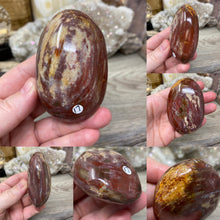#17 ~ 165g / 0.364lbs / 5.82oz ~ 2.92” x 1.95” x 1.27”
#18 ~ 167g / 0.368lbs / 5.89oz ~ 2.26” x 2.14” x 1.44”
#19 ~ 171g / 0.377lbs / 6.03oz ~ 2.69” x 2.25” x 1.20”
Petrified Wood (also called fossilized wood or agatized wood) is a member of the Quartz family, a silicon dioxide mineral with a hardness of 6.5 to 7. Its crystal system is hexagonal (trigonal).
After a volcanic eruption, trees were buried by ash and lava eliminating any microbes that would rot the wood, this allows for petrification, which preserves a large proportion of the original form of the wood. Growth rings, outer bark and even worm holes in the wood can be preserved in this process. The wood is then replaced with silica, rich minerals, such as Chalcedony, Calcite, Quartz, Opal, and Jasper.
The beautiful colors in the wood come from assorted trace elements. Traces of Manganese creates blue and black colors. Traces of iron would result in different shades of brown and orange. You can find Petrified Wood with colors of brown, gray, yellow, red, black, and even blue or violet colors.
The most spectacular Petrified Wood locality is near Holbrook, Arizona, where fossilized tree trunks of up to 213 feet long have been found. About 200 million years ago, water deposited the tree trunks in this area, then covered it with sediment hundreds of yards thick. Eventually, some of the fossilized wood was exposed by weathering. The Petrified Wood of this locality is the most spectacularly colored of any in the world, and in 1962, the “Petrified Forest” was made into a national park.








